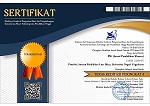Meningkatkan Konsentrasi pada Anak dengan Sindrom Down Melalui Intervensi Motorik Berbasis Keluarga: Studi Penelitian Subjek Tunggal
Downloads
Penelitian ini mengeksplorasi kemanjuran intervensi motorik berbasis keluarga dalam meningkatkan tingkat konsentrasi pada anak dengan sindrom Down menggunakan desain Single Subject Research (SSR). Dua anak usia sekolah dasar dengan sindrom Down berpartisipasi dalam penelitian ini. Intervensi terdiri dari aktivitas motorik terstruktur, yang dilaksanakan di lingkungan rumah dengan keterlibatan orang tua. Data dikumpulkan menggunakan pengamatan perilaku dan penilaian konsentrasi standar di seluruh fase awal, intervensi, dan tindak lanjut. Hasil menunjukkan peningkatan konsentrasi Hasil menunjukkan peningkatan konsentrasi yang signifikan dengan rata-rata 40% dan 35% setelah intervensi. Temuan ini menunjukkan potensi aktivitas motorik berbasis keluarga untuk mendukung perkembangan kognitif pada anak-anak dengan sindrom Down dan rekomendasi untuk menerapkan intervensi serupa dalam konteks Pendidikan dan terapi.
Downloads
AMER, W. (2024). The use of occupational therapy in oral motor disorders and dysphoria in children with down syndrome. The Medical Journal of Cairo University, 91(12), 1529-1538. https://doi.org/10.21608/mjcu.2024.342732
Connolly, B. and Michael, B. (1986). Performance of retarded children, with and without down syndrome, on the bruininks oseretsky test of motor proficiency. Physical Therapy, 66(3), 344-348. https://doi.org/10.1093/ptj/66.3.344
Davis, A. (2008). Children with down syndrome: implications for assessment and intervention in the school.. School Psychology Quarterly, 23(2), 271-281. https://doi.org/10.1037/1045-3830.23.2.271
Harum, D. (2023). The effectiveness of using clay media in improving the fine motor ability of down syndrome children. Special Special and Inclusive Education Journal, 4(1), 10-18. https://doi.org/10.36456/special.vol4.no1.a6927
Kashi, A., Dawes, H., Mansoubi, M., & Sarlak, Z. (2023). The effect of a physical exercise package on the motor proficiency of students with down syndrome. Iranian Journal of Pediatrics, 33(1). https://doi.org/10.5812/ijp-120408
Kiran, Q., Afzal, A., Anjum, H., Shahid, B., Shahzad, A., & Hassan, D. (2022). Effect of proprioceptive neuromuscular facilitation on basic motor skills in children with down syndrome. PJMHS, 16(10), 630-632. https://doi.org/10.53350/pjmhs221610630
Lersilp, S., Putthinoi, S., & Panyo, K. (2016). Fine motor activities program to promote fine motor skills in a case study of down's syndrome. Global Journal of Health Science, 8(12), 60. https://doi.org/10.5539/gjhs.v8n12p60
Lewis, E. and Kritzinger, A. (2004). Parental experiences of feeding problems in their infants with down syndrome. Down Syndrome Research and Practice, 9(2), 45-52. https://doi.org/10.3104/reports.291
Mahoney, G. and Perales, F. (2006). The role of parents in early motor intervention. Down Syndrome Research and Practice, 10(2), 67-73. https://doi.org/10.3104/reviews.307
Malak, R., Kostiukow, A., Krawczyk-Wasielewska, A., Mojs, E., & Samborski, W. (2015). Delays in motor development in children with down syndrome. Medical Science Monitor, 21, 1904-1910. https://doi.org/10.12659/msm.893377
Norlaili Mat Safri, Siti Nur Ayasy Md Brahim, Lim Zhi Qing, Raymond Teoh Yong Sheng, Nurul Syafira Ahmad Rodi. (2023). Fine motor training using conventional tools, 3d-printed toys and digital platform. International Journal for Multidisciplinary Research, 5(6). https://doi.org/10.36948/ijfmr.2023.v05i06.9934
Parhoon, K., Parhoon, H., & Movallali, G. (2014). Effectiveness of training sensory stimulation on gross motor skills of 5-7 years old children with down syndrome. International Journal of Academic Research in Psychology, 1(1). https://doi.org/10.6007/ijarp/v1-i1/722
Popa, C. and Dobrescu, T. (2017). The effectiveness of therapeutic physical exercises in improving balance and coordination in children with down syndrome. Revista Romaneasca Pentru Educatie Multidimensionala, 9(3), 89-102. https://doi.org/10.18662/rrem/2017.0903.06
Popescu, O. and Leonte, N. (2019). Analyzation of the handling skills training level in children suffering from the down syndrome. Gymnasium, 20(1), 5-19. https://doi.org/10.29081/gsjesh.2019.20.1.01
Puspitosari, A. (2021). Sandsack physical activity increasing balance score in children with down syndrome. Jurnal Keterapian Fisik, 49-57. https://doi.org/10.37341/jkf.v0i0.254
Russell, D., Heerden, R., Vuuren, S., Venter, A., & Joubert, G. (2016). The impact of the "developmental resource stimulation programme" (drsp) on children with down syndrome. South African Journal of Occupational Therapy, 46(1). https://doi.org/10.17159/2310-3833/2016/v46n1a8
Wishart, J. (1993). Learning the hard way: avoidance strategies in young children with down syndrome. Down Syndrome Research and Practice, 1(2), 47-55. https://doi.org/10.3104/reviews.10
Copyright (c) 2025 JPK (Jurnal Pendidikan Khusus)

This work is licensed under a Creative Commons Attribution-ShareAlike 4.0 International License.
The copyright of the accepted for publication articles shall be assigned to JPK (Jurnal Pendidikan Khusus) as the publisher of the journal. The intended copyright includes the rights to publish articles in various forms (including reprints).














